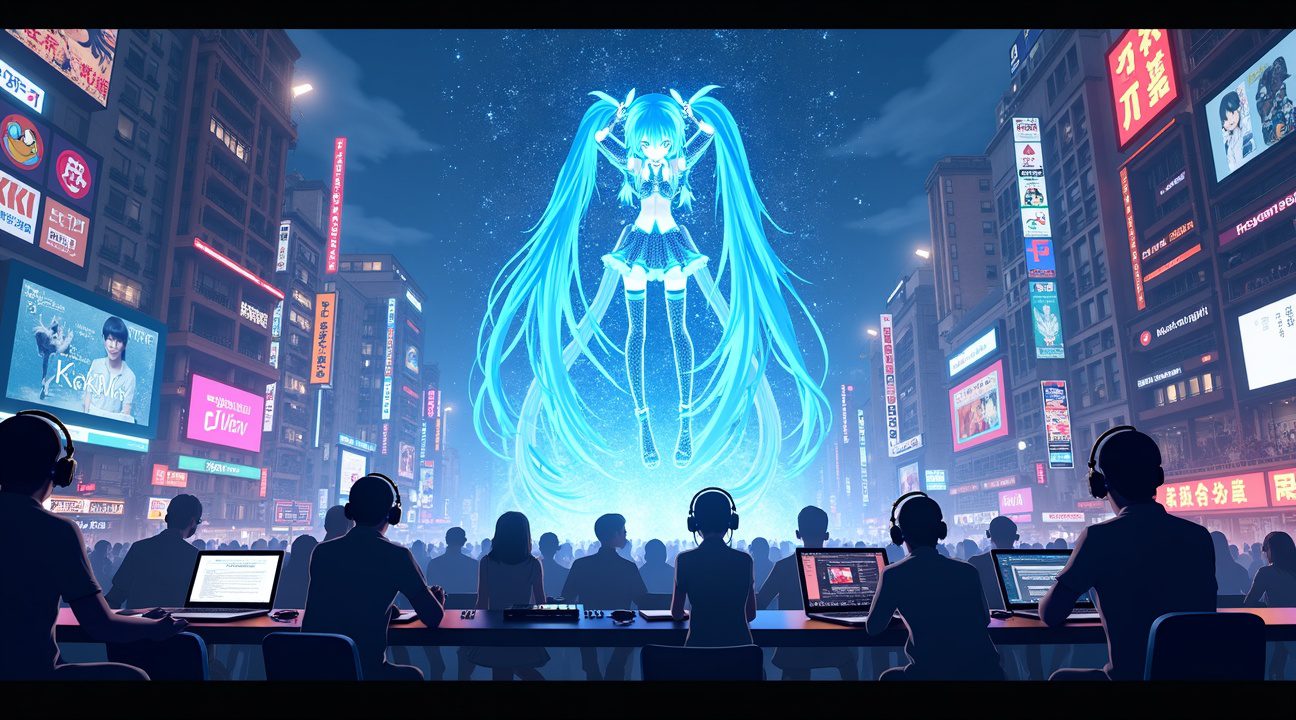Hatsune Miku transformed Japan’s music industry by democratizing music production and creating an entirely new model of celebrity culture driven by fan creativity rather than corporate control.
This virtual idol evolved from vocal synthesis software into a global cultural phenomenon worth 10 billion yen, proving that digital performers could achieve mainstream commercial success while fostering unprecedented community-driven artistic expression.
Key Takeaways
- Commercial breakthrough: Miku achieved 40,000 units sold within one year and became the first Vocaloid album to top Japan’s Oricon Weekly Chart, establishing virtual performers as commercially viable entertainers.
- Democratized music creation: The VOCALOID technology made professional-quality music production accessible to bedroom producers and amateur musicians, eliminating traditional industry gatekeepers and studio barriers.
- Community-driven success: Fan recognition jumped from 60% to 95% between 2010-2013 through grassroots creativity rather than corporate marketing, with fans actively creating content instead of passively consuming it.
- Global cultural impact: International expansion generated 10 billion yen in merchandise sales and established new models for cross-cultural entertainment through hologram concerts and gaming collaborations worldwide.
- Social influence beyond entertainment: Miku became a force for disaster relief following the 2011 Tohoku earthquake and gained educational applications, demonstrating how virtual characters can mobilize real-world positive action.
Further Exploration
Fans and creators continue to actively engage with Hatsune Miku through platforms like Piapro and virtual live performances such as Miku Expo. These online hubs and events foster collaboration and push the boundaries of what a modern music idol can be in a digital age.
The World’s First Virtual Superstar Sells 40,000 Units in One Year
Breaking Sales Records and Industry Expectations
Hatsune Miku burst onto the scene in August 2007, marking a revolutionary moment in Japan’s music industry. Crypton Future Media’s creation, powered by Yamaha’s VOCALOID vocal synthesis software, achieved something unprecedented – a virtual singer that could captivate audiences and drive impressive sales numbers. By July 2008, just one year after her debut, Miku had sold an astounding 40,000 units, proving that audiences were ready to embrace digital performers.
Sales momentum didn’t stop there. By January 2011, the virtual idol had reached 60,000 units sold, cementing her position as a genuine commercial phenomenon. On September 12, 2007, just one month after launch, sales had already totaled 57,500,000 yen, making her the top-selling music software in Japan at that time. These figures weren’t just impressive – they were game-changing for an industry accustomed to traditional human performers.
Democratizing Music Production Through Technology
Miku’s impact extended far beyond sales figures. She fundamentally shifted the paradigm from human performers to digital icons, opening doors that had previously been closed to amateur musicians. The VOCALOID2 technology made advanced music production accessible to anyone with a computer and creative vision. Bedroom producers could now create professional-sounding vocals without needing expensive studio time or vocal talent.
This accessibility sparked a creative revolution. Independent artists began experimenting with Miku’s voice, creating everything from pop ballads to electronic dance tracks. The virtual singer became a canvas for musical expression, allowing creators to focus purely on composition and arrangement. Her success demonstrated that audiences didn’t need human performers to form emotional connections with music – they could bond with digital characters just as deeply.
The phenomenon extended beyond Japan’s borders, influencing global entertainment culture and inspiring similar virtual performers worldwide. Miku’s commercial breakthrough proved that technology could create new categories of entertainers, paving the way for an entirely new industry of virtual influencers and digital performers. Her success story continues to inspire creators who see technology as a tool for artistic expression rather than a replacement for human creativity.
https://www.youtube.com/watch?v=DTXO7KGHtjI
https://www.youtube.com/watch?v=vPBRj0bE55w
From 60% to 95% Recognition: How Fans Became the Driving Force
I’ve observed how Hatsune Miku transformed Japan’s music landscape by inverting traditional industry power structures. Rather than relying on corporate marketing campaigns, she sparked an unprecedented wave of fan-driven creativity that fundamentally changed how music gets created and consumed.
The Recognition Revolution
Tokyo Polytechnic University survey data reveals a remarkable trajectory in Miku’s cultural penetration. Recognition jumped from 60% in 2010 to an impressive 95% by 2013. This explosive growth didn’t happen through conventional promotional strategies. Instead, it emerged from a grassroots movement where fans became active participants rather than passive consumers.
The shift represents something far more significant than celebrity status. Miku became a cultural catalyst, enabling thousands of amateur creators to produce professional-quality content. Musicians who couldn’t afford studio time or vocalists suddenly had access to a sophisticated voice synthesis platform. Artists could experiment without the traditional barriers that prevented entry into Japan’s music industry.
Doujin Culture: The Engine of Sustained Growth
Japan’s doujin culture provided the perfect foundation for Miku’s success. This fan-created content ecosystem already existed, but Miku supercharged it by offering accessible tools for music production. Vocalo-P (Vocaloid Producers) emerged as a new creative class, developing followings that rival traditional recording artists.
The participatory nature of this movement sets it apart from typical idol phenomena. Fans don’t just consume Miku’s content – they actively create it. User-generated content flows constantly through platforms like Niconico, where new songs, remixes, and derivative works appear daily. This cultural phenomenon demonstrates how digital tools can democratize creative expression.
Success stories from bedroom producers illustrate this transformation. Independent creators have launched careers by producing Miku songs that gain millions of views. The producer-to-audience pipeline operates without traditional gatekeepers, allowing talent to rise based purely on creative merit and community response.
This bottom-up approach contrasts sharply with the top-down model that dominated Japan’s music industry for decades. Record labels previously controlled which artists received promotion and distribution. Now, any creator with software and imagination can potentially reach massive audiences. The result has been an explosion of musical diversity and experimentation that continues to shape Japanese pop culture and influence artists worldwide.

Making History: First Vocaloid Album to Top Japan’s Charts
Miku’s breakthrough transformed J-pop by democratizing music production, enabling anyone with a computer to create and share songs digitally. This revolutionary shift eliminated traditional industry gatekeepers, allowing unknown artists to achieve global recognition without record label support or expensive studio time.
In May 2010, history was made when an album featuring Hatsune Miku became the first Vocaloid album to reach the top of Japan’s prestigious Oricon Weekly Chart. This milestone marked a pivotal moment in Japanese music history, proving that virtual performers could compete with established human artists in commercial success. The achievement demonstrated how digital innovation was reshaping the music landscape, much like how Japan’s music culture has continuously evolved with technological advances.
Mainstream Cultural Penetration
The success of “Tell Your World” by Livetune feat. Hatsune Miku in 2012 exemplified her deep penetration into mainstream Japanese culture through digital platforms. This track became an anthem for the digital generation, showcasing how Vocaloid music could transcend niche communities and reach broader audiences. The song’s popularity on platforms like YouTube and Nico Nico Douga illustrated the power of user-generated content in driving cultural phenomena.
A new generation of creators, termed Vocalo-native, emerged from this digital revolution. These artists discovered music through Vocaloid technology rather than traditional means, fundamentally reshaping their approach to composition and production. The Vocalo-native generation brings fresh perspectives to pop music, incorporating electronic elements and unconventional song structures that reflect their digital-first musical education.
This transformation parallels broader cultural shifts in Japan, where anime captured global attention through similar digital distribution methods. The success of Vocaloid music on the Oricon chart validated digital platforms as legitimate venues for artistic expression and commercial success, encouraging more independent creators to pursue music production without traditional industry backing.
The impact extends beyond charts and sales figures. Miku’s success demonstrated that authenticity in music doesn’t require human vocals, opening new creative possibilities for composers who could now focus purely on melody and production without vocal performance limitations. This shift has influenced mainstream J-pop artists who increasingly incorporate Vocaloid-inspired elements into their work, creating a feedback loop between digital and traditional music production methods.
10 Billion Yen Empire: Global Concerts and Cultural Exchange
Hatsune Miku’s transformation from a Japanese vocal synthesis software into a global cultural phenomenon represents one of the most remarkable success stories in modern entertainment. Crypton Future Media’s strategic decision to market Miku internationally has created an empire that transcends language barriers and cultural boundaries, generating massive revenue streams while fostering unprecedented cross-cultural collaboration.
The virtual idol’s global expansion began with deliberate international marketing efforts, including the release of an English version specifically designed to penetrate Western markets. This strategic move opened doors to audiences who previously couldn’t engage with Japanese-language content, demonstrating how technology can bridge cultural gaps in ways traditional artists never could.
Financial success followed quickly, with merchandise and related goods sales reaching an estimated 10 billion yen by 2012, just five years after Miku’s initial release. This staggering figure reflects not just commercial success but the creation of an entirely new entertainment category that combines music, technology, and fan participation in unprecedented ways.
Interactive Entertainment and Cross-Cultural Adaptation
Gaming platforms have become crucial venues for Miku’s global reach, with major titles like ‘Hatsune Miku: Project DIVA’ from Sega and ‘Hatsune Miku and Future Stars: Project Mirai’ for Nintendo 3DS establishing her presence in interactive entertainment. These games don’t simply feature Miku as a character; they create immersive experiences where players participate in her musical performances, blurring the lines between audience and performer.
Licensed appearances extend her influence even further, with notable inclusions in diverse titles such as:
- ‘Persona 4: Dancing All Night’
- ‘Just Dance’
- ‘Skullgirls’
Each appearance introduces Miku to different gaming communities, expanding her fanbase across various demographics and interests.
Regional reinterpretations showcase Miku’s remarkable adaptability as a cultural icon. Catalan fans have created unique blends of Miku content with local traditions, while K-pop collaborations with Korean artists demonstrate her ability to transcend not just geographical boundaries but musical genres as well. These cross-cultural exchanges create new forms of artistic expression that wouldn’t exist without Miku’s open-source approach to creativity.
Official concerts in the United States and Europe have brought Miku’s signature hologram performances to international stages, creating shared experiences that unite fans regardless of their cultural backgrounds. These real-time 3D hologram concerts represent cutting-edge entertainment technology, positioning Japan as a leader in innovative performance art while creating new models for how music can be experienced globally.
The regular concert tours have become cultural events that extend far beyond simple musical performances. Fans from different countries share creative works, collaborate on projects, and form communities that demonstrate how anime culture can create lasting international connections.
Miku’s global impact also highlights interesting parallels with other aspects of Japanese culture’s international reach. Just as Japanese music genres have found new audiences worldwide, Miku’s success demonstrates how technology can amplify cultural exchange in unexpected ways.
The phenomenon extends beyond entertainment into educational collaborations, such as language learning partnerships that use popular culture to teach Japanese to international audiences. This creates a self-reinforcing cycle where Miku’s popularity drives interest in Japanese culture, which in turn creates more opportunities for cultural exchange.
International success has also influenced how other Japanese entertainment properties approach global markets, with Miku serving as a proof of concept for how virtual characters can achieve worldwide recognition. Her model demonstrates that cultural products don’t need to conform to Western standards to achieve international success; instead, authenticity and innovative presentation can create new market categories entirely.

Digital Identity Revolution: Community-Controlled Celebrity Culture
Hatsune Miku’s emergence reshaped celebrity culture in Japan by placing creative control directly into fans’ hands rather than corporate boardrooms. I observe how this virtual idol operates as more than entertainment—she represents a fundamental shift toward community-driven stardom that challenges traditional media hierarchies.
The digital diva embodies Japanese kawaii culture while serving practical roles, from appearing in educational textbooks to functioning as an unofficial mascot for Hokkaido. Her versatility demonstrates how technology enables a hybrid creative economy where fans contribute equally to her catalog and image alongside corporate-sponsored content. This collaborative approach generates a self-sustaining ecosystem that continuously evolves through community input.
Technology Bridging Isolation and Creative Expression
Miku’s rise coincided with significant social shifts in Japan, particularly the emergence of ‘soshoku danshi’ (herbivore men) who gravitate toward digital interactions over traditional socializing patterns. Her platform provides an outlet for creative expression that doesn’t require face-to-face interaction, making music creation accessible to introverted artists. Technology mediates between personal isolation and community engagement, allowing creators to participate in Japan’s music scene without conventional social pressures.
The market surrounding her character supports a self-generating network of interactivity that builds a unique fan economy. Creators produce original songs, artwork, and videos using her voice, while other fans consume, remix, and redistribute this content across digital platforms. This cycle creates value without traditional gatekeepers, establishing new economic models for creative industries.
Unlike conventional celebrities whose reputations are media-managed, Miku’s image remains community-controlled. Fans collectively shape her personality, visual representation, and musical direction through their contributions. This democratic approach to celebrity construction reflects broader cultural movements toward participatory media and user-generated content that have influenced global entertainment.
Her success illustrates how digital identity can transcend physical limitations while maintaining authentic cultural connections. The character adapts to technological advances and social changes because her community actively reimagines her relevance. This flexibility ensures longevity in fast-changing digital landscapes where traditional celebrities might struggle to maintain relevance without constant media management.
Beyond Entertainment: Disaster Relief and Social Impact
I’ve witnessed how Hatsune Miku transcended her digital origins to become a powerful force for social good in Japanese society. Her most significant humanitarian contribution emerged following the devastating 2011 Tohoku earthquake and tsunami, when she became the recognizable face of Cheerful JAPAN!, an ambitious disaster relief campaign. This initiative demonstrated how virtual characters could mobilize real-world support through the strategic sale of special commemorative figures, with proceeds directly supporting recovery efforts.
The campaign’s success revealed something profound about Miku’s cultural resonance. Unlike traditional celebrity endorsements, her involvement felt authentic to fans because she represented their collective creative spirit rather than corporate interests. Crypton Future Media leveraged this connection brilliantly, understanding that Miku’s community would rally around her charitable initiatives with the same passion they brought to creating music and art.
Educational Innovation and Community Building
Educational institutions across Japan began incorporating Miku into their materials, recognizing her unique ability to engage students with technology and creative expression. Music programs used her Vocaloid software to teach composition and digital music production, while computer science courses employed her as a gateway to understanding artificial intelligence and voice synthesis technology. This educational integration helped normalize digital culture in academic settings.
Charity events featuring Miku have become regular occurrences throughout Japan, from benefit concerts to fundraising campaigns for various causes. These events consistently draw massive crowds, proving her sustained ability to mobilize communities for positive action. Her virtual nature actually enhances these efforts – she can appear at multiple events simultaneously, maximizing her charitable impact without the logistical constraints that limit human celebrities.
The Economic Engine of Fan Culture
The merchandising phenomenon surrounding Miku has created an entire economic ecosystem that extends far beyond traditional entertainment products. Fans eagerly purchase figures, digital albums, apparel, and countless other items featuring her likeness, generating substantial revenue streams that support both official creators and independent artists. This fan economy operates on principles of genuine enthusiasm rather than manufactured demand.
What sets Miku’s merchandising apart is its democratic nature. While official products generate significant sales, the thousands of fan-created remixes, illustrations, and stories form an equally important part of her cultural footprint. These user-generated works often surpass official content in creativity and emotional impact, creating a feedback loop where fan enthusiasm drives official support, which in turn enables more fan creativity.
- Digital albums featuring fan compositions have achieved remarkable commercial success, with some reaching the top of Japanese music charts.
- Independent artists have built careers around Miku-related content, from music producers to visual artists to writers.
The merchandising strategy also reflects broader changes in Japanese popular culture, where virtual characters increasingly serve as focal points for community identity. Fans don’t just consume Miku products – they actively participate in creating her cultural meaning through their purchases, creations, and social interactions.
This economic model has influenced how other virtual characters and franchises approach merchandising, establishing new standards for authentic community engagement. Companies have learned that sustainable fan economies require genuine creative freedom and meaningful ways for supporters to contribute to their favorite characters’ ongoing development.
The social impact extends beyond immediate charitable works or educational applications. Miku has helped normalize the concept of virtual personalities as legitimate cultural figures, paving the way for broader acceptance of digital culture in traditional Japanese society. Her success demonstrates how technology can enhance rather than replace human creativity, offering an optimistic vision of human-AI collaboration that resonates globally.
Sources:
National High School Journal of Science – “VOCALOID Phenomenon: Deconstruction of Music Culture Through Hatsune Miku”
Pebble Galaxy – “Hatsune Miku: Exploring the Global Impact of Japan’s Digital Idol Across Cultures”
Nippon.com – “Hatsune Miku: The Virtual Singer with a Real-World Following”
YumeTwins Blog – “Who is Hatsune Miku?”
Wikipedia – “Hatsune Miku”
University of California, Irvine Humanities Department – “Examining the Rise of Hatsune Miku: The First International Virtual Idol”
The Japan Forum – “How Hatsune Miku Was Born”


